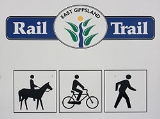
Rail trail
Encyclopedia
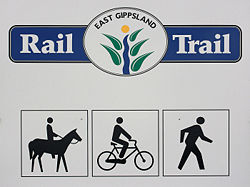
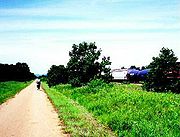
Rails with trails
Rails with trails are a small subset of rail trails in which a railway right-of-way remains in use by trains yet also has a parallel recreational trail. Hundreds of kilometers of RWTs exist in the United States, Canada, Europe, and Western Australia.- United States :In the United States the...
". Some shared trails are segregated, with the segregation achieved with or without separation. Many rail trails are long distance trails.
A rail to trail may still include rails, such as light rail
Light rail
Light rail or light rail transit is a form of urban rail public transportation that generally has a lower capacity and lower speed than heavy rail and metro systems, but higher capacity and higher speed than traditional street-running tram systems...
or streetcar
Tram
A tram is a passenger rail vehicle which runs on tracks along public urban streets and also sometimes on separate rights of way. It may also run between cities and/or towns , and/or partially grade separated even in the cities...
. By virtue of their characteristic shape (long and flat), some shorter rails to trails are known as greenways
Greenway (landscape)
A greenway is a long, narrow piece of land, often used for recreation and pedestrian and bicycle user traffic, and sometimes for streetcar, light rail or retail uses.- Terminology :...
and linear park
Linear park
A linear park is a park that is much longer than wide. It is often formed as a part of a rails-to-trails conversion of railroad beds to rail trail recreational use...
s.
United States
In North America, the decades-long consolidation of the rail industry led to the closure of a number of uneconomical branch lines in the 1960s. Some were maintained as short line railways, but many others were abandoned.Beginning with a few lines in the Midwestern United States
Midwestern United States
The Midwestern United States is one of the four U.S. geographic regions defined by the United States Census Bureau, providing an official definition of the American Midwest....
, these disused industrial relics were turned into ecological areas functioning as linear parks or community space, but mainly as non-motorized transportation or recreation corridors for walking, hiking, bicycling, horse riding, birdwatching, etc.
By the 1970s, even main lines were being sold or abandoned. This was especially true when regional rail lines merged and streamlined their operations. As both the supply of potential trails increased and awareness of the possibilities rose, state governments, municipalities, conservation authorities and private organizations bought the rail corridors to create, expand or link greenspace
Open space reserve
Open space reserve, open space preserve, and open space reservation, are planning and conservation ethics terms used to describe areas of protected or conserved land or water on which development is indefinitely set aside...
s. The first abandoned rail corridor in the United States converted into a recreational trail was the Elroy-Sparta State Trail
Elroy-Sparta State Trail
The Elroy-Sparta Bike Trail is a rail trail between Elroy and Sparta, Wisconsin.It is one of four connecting bike trails in west-central Wisconsin that spans approximately one-third of the state. The trail is known for its rural scenery and three tunnels...
in Wisconsin
Wisconsin
Wisconsin is a U.S. state located in the north-central United States and is part of the Midwest. It is bordered by Minnesota to the west, Iowa to the southwest, Illinois to the south, Lake Michigan to the east, Michigan to the northeast, and Lake Superior to the north. Wisconsin's capital is...
, which opened in 1965. The following year the Illinois Prairie Path
Illinois Prairie Path
The Illinois Prairie Path is a network of of bicycle trails, mostly in DuPage County, Illinois. Portions of the trail extend west to Kane County and east to Cook County. Most of the trail is categorized as rail-to-trail, meaning that the bicycle path is built atop an old railroad right of way...
opened. The longest developed rail trail is currently the 225-mile Katy Trail
Katy Trail State Park
The Katy Trail State Park is a recreation rail trail that runs in the right-of-way of the former Missouri-Kansas-Texas Railroad. The nickname "Katy" comes from the phonetic pronunciation of 'KT' in the railroad's abbreviated name, MKT. The trail, widely known as the Katy Trail, is a Missouri...
in Missouri
Missouri
Missouri is a US state located in the Midwestern United States, bordered by Iowa, Illinois, Kentucky, Tennessee, Arkansas, Oklahoma, Kansas and Nebraska. With a 2010 population of 5,988,927, Missouri is the 18th most populous state in the nation and the fifth most populous in the Midwest. It...
; when complete, the Cowboy Trail
Cowboy Trail
The Cowboy Trail is a rail trail in northern Nebraska. It is a multi-use recreational trail suitable for bicycling, walking and horseback riding. It occupies an abandoned Chicago and North Western Railway corridor. When complete, the trail will run from Chadron to Norfolk, a length of 321 miles ,...
in Nebraska
Nebraska
Nebraska is a state on the Great Plains of the Midwestern United States. The state's capital is Lincoln and its largest city is Omaha, on the Missouri River....
will extend for 321 miles.
The conversion of rails to trails hastened with the federal government passing legislation promoting the use of railbanking for abandoned railroad corridors. This process would preserve rail corridors for possible future rail use with interim use as a trail.
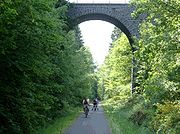
United Kingdom
The development or rail trails grow after the beeching cutsBeeching Axe
The Beeching Axe or the Beeching Cuts are informal names for the British Government's attempt in the 1960s to reduce the cost of running British Railways, the nationalised railway system in the United Kingdom. The name is that of the main author of The Reshaping of British Railways, Dr Richard...
. The majority of rail trails are maintained by either the local authority
Local government in the United Kingdom
The pattern of local government in England is complex, with the distribution of functions varying according to the local arrangements. Legislation concerning local government in England is decided by the Parliament and Government of the United Kingdom, because England does not have a devolved...
or the charity sustrans
Sustrans
Sustrans is a British charity to promote sustainable transport. The charity is currently working on a number of practical projects to encourage people to walk, cycle and use public transport, to give people the choice of "travelling in ways that benefit their health and the environment"...
.
Australia
The development of rail trails in southeastern Australia can be traced to the gold rushesAustralian gold rushes
The Australian gold rush started in 1851 when prospector Edward Hammond Hargraves claimed the discovery of payable gold near Bathurst, New South Wales, at a site Edward Hargraves called Ophir.Eight months later, gold was found in Victoria...
of the second half of the 19th century. Dozens of rail lines sprang up, aided by the overly enthusiastic "Octopus Act
Railway Construction Act 1884
The Victorian Government's Act No. 821, Railway Construction Act 1884, authorised the construction of 59 new railway lines. Created by the Minister for Railways, Thomas Bent, and passed on 12 December 1884, it became notorious for the excessive number of inner-city railways it created, and received...
", but soon became unprofitable as the gold ran out, leading to a decreased demand for timber in turn. Decades later, these easements found a new use as tourist drawcards, once converted to rail trails. Dozens exist in some form, but only a few — such as the 95 kilometre Murray to the Mountains Rail Trail
Murray to the Mountains Rail Trail
The Murray to the Mountains Rail Trail is a cycling and walking rail trail in northern Victoria, Australia. It extends from Wangaratta to Bright, with a side branch to Beechworth, following the route of the former Bright railway line...
— have been fully developed. Progress is frequently hampered by trestle bridges in unsafe condition, easements that have been sold off to farmers, and lack of funds. Funding is typically contributed in roughly equal parts from federal, state and local governments, with voluntary labour and in kind donations contributed by local groups.
New Zealand
A number of rail trails have been established through New Zealand, the most well known are the Otago Central Rail TrailOtago Central Rail Trail
The Otago Central Rail Trail is a 150-kilometre walking, cycling and horse riding track in the South Island of New Zealand. It runs in an arc between Middlemarch and Clyde, along the route of the former Otago Central Railway...
and the Little River Rail Trail
Little River Rail Trail
The Little River Rail Trail is a cycling and walking track on Banks Peninsula in the Canterbury region of New Zealand's South Island.-Location:...
. The New Zealand Cycle Trail project, which is a Government-led initiative, will greatly accelerate the establishment of new trails. The first seven projects (not all of them rail trails, though) were announced in July 2009 and will receive $9 million in funding of the total project budget of $50 million.
Other countries
There are tens of thousands of miles and thousands of rail trails in the United States, Canada, United Kingdom, Australia and many other countries. The main factor restricting the potential scope of the movement is the lack of abandoned or surplus rail lines in continental EuropeEurope
Europe is, by convention, one of the world's seven continents. Comprising the westernmost peninsula of Eurasia, Europe is generally 'divided' from Asia to its east by the watershed divides of the Ural and Caucasus Mountains, the Ural River, the Caspian and Black Seas, and the waterways connecting...
, though abandoned canal
Canal
Canals are man-made channels for water. There are two types of canal:#Waterways: navigable transportation canals used for carrying ships and boats shipping goods and conveying people, further subdivided into two kinds:...
towpath
Towpath
A towpath is a road or trail on the bank of a river, canal, or other inland waterway. The purpose of a towpath is to allow a land vehicle, beasts of burden, or a team of human pullers to tow a boat, often a barge...
s are readily available and used for similar purposes.
Conversion issues
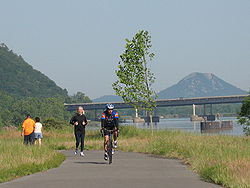
Railroad property rights have often been poorly defined and sporadically enforced, with neighboring property owners intentionally or accidentally using land they do not own. Such encroachers often later oppose a rail to trail conversion. Even residents who are not encroaching on railway lands may oppose conversion on the grounds of increased traffic in the area and the possibility of a decline in personal security.
Because linear corridors of land are only valuable if they are intact, special laws regulate the abandonment of a railroad corridor. In the United States, the Surface Transportation Board
Surface Transportation Board
The Surface Transportation Board of the United States is a bipartisan, decisionally-independent adjudicatory body organizationally housed within the U.S. Department of Transportation. The STB was established in 1996 to assume some of the regulatory functions that had been administered by the...
regulates railroads, and can allow a corridor to be "rail banked" or placed on hold for possible conversion back to active status when or if future need demands.
While many rail trails have been built, many more potential trails have been squashed by community opposition. The stature of the conversion organization, the quality of involvement of the local community, and government willingness are all keys factor in the successful acceptance of a trail.
Typical features
Most original rail linesRail transport
Rail transport is a means of conveyance of passengers and goods by way of wheeled vehicles running on rail tracks. In contrast to road transport, where vehicles merely run on a prepared surface, rail vehicles are also directionally guided by the tracks they run on...
were surveyed
Surveying
See Also: Public Land Survey SystemSurveying or land surveying is the technique, profession, and science of accurately determining the terrestrial or three-dimensional position of points and the distances and angles between them...
for ease of transport and gentle (often less than 2%) grades. Therefore, the rail trails that succeeded them are often fairly straight and ideally suited to overcome steep or awkward terrain such as hills, escarpments, rivers, swamps, etc. Rail trails often share space with linear utilities
Utility
In economics, utility is a measure of customer satisfaction, referring to the total satisfaction received by a consumer from consuming a good or service....
such as pipeline
Pipeline transport
Pipeline transport is the transportation of goods through a pipe. Most commonly, liquids and gases are sent, but pneumatic tubes that transport solid capsules using compressed air are also used....
s, electrical transmission wires and telephone line
Telephone line
A telephone line or telephone circuit is a single-user circuit on a telephone communication system...
s.
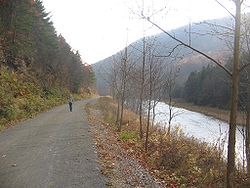

A railroad right-of-way (easement)
Right-of-way (railroad)
A right-of-way is a strip of land that is granted, through an easement or other mechanism, for transportation purposes, such as for a trail, driveway, rail line or highway. A right-of-way is reserved for the purposes of maintenance or expansion of existing services with the right-of-way...
width varies based on the terrain, with 30 m or 98.4 ft being amply wide enough where little surface grading is required. The initial 705 miles or 1,134.6 km stretch of the Illinois Central Railroad
Illinois Central Railroad
The Illinois Central Railroad , sometimes called the Main Line of Mid-America, is a railroad in the central United States, with its primary routes connecting Chicago, Illinois with New Orleans, Louisiana and Birmingham, Alabama. A line also connected Chicago with Sioux City, Iowa...
is the most liberal in the world with a width of 200 ft or 61 m along the whole length of the line. Rail trails are often graded and covered in gravel or crushed stone, although some are paved with asphalt
Asphalt
Asphalt or , also known as bitumen, is a sticky, black and highly viscous liquid or semi-solid that is present in most crude petroleums and in some natural deposits, it is a substance classed as a pitch...
and others are left as dirt. Where rail bridges are incorporated into the trail, the only alterations (if any) tend to be adding solid walking areas on top of ties or trestles. If paved, they are especially suitable for people in wheelchairs.
Where applicable, the same trails used in the summer for walking, jogging and inline skating can be used in the winter for Nordic skiing
Nordic skiing
Nordic skiing is a winter sport that encompasses all types of skiing where the heel of the boot cannot be fixed to the ski, as opposed to Alpine skiing....
, snowshoe
Snowshoe
A snowshoe is footwear for walking over the snow. Snowshoes work by distributing the weight of the person over a larger area so that the person's foot does not sink completely into the snow, a quality called "flotation"....
ing and sometimes snowmobiling.
Railbanking
Railbanking is preserving railroad rights-of-wayRight-of-way (railroad)
A right-of-way is a strip of land that is granted, through an easement or other mechanism, for transportation purposes, such as for a trail, driveway, rail line or highway. A right-of-way is reserved for the purposes of maintenance or expansion of existing services with the right-of-way...
for possible future use. Railbanking leaves the tracks, bridges, and other infrastructure intact, relieving the railroad operating company from responsibility of maintenance and taxation. Often the tracks are put in custody of a state transportation agency, who then seeks a new operator for possible rehab or reactivation. This helps ensure the possibility of future restored rail service when new economic conditions may warrant resuming operation.
In places with many environmental laws and other governmental regulations as the United States
United States
The United States of America is a federal constitutional republic comprising fifty states and a federal district...
, it is very difficult to restore an abandoned line, but it is easier with a railbanked line than one that has undergone a "total abandonment", as the Federal government guarantees the railroad the full rights to reactivate it. A railbanked line can be reopened within a year's time while an abandoned corridor could take years to be reactivated, if it was even possible. In railbanking, the government helps fund the line's rebuild. 14,184 route miles (22,694 route km) of railroad have been abandoned in the 25 year time period from 1983 to 2008. Of that, 8056.5 miles (12,890 km), representing 56.8% of the lines abandoned in the past 25 years, were originally negotiated for railbanking agreements.
21% of those railbanking agreements failed; that is they were ultimately abandoned. Thus 5079 miles (8126 km) of those originally negotiated 8,056.5 miles (12,890 km) actually reached a railbanking agreement, representing 35.8% of the lines abandoned during the 25-year time period. The remaining 43.2% of the lines not yet mentioned, representing 6,127.5 miles (9804 km) were lines that railroads never even considered trying to have railbanked, and were totally abandoned. In total, 9,105 miles (14,568 km) of the 14,184 miles abandoned during the 25-year time period were not railbanked, or about 64.2%. Some bold railroads even refused to railbank lines, and would instead sell the land in parcels to the surrounding landowners.
Since railbanking began in 1983, nine railbanked corridors have been approved for reactivation by the STB. Some of these reactivated corridors had only short sections reactivated, while others had the entire corridor reactivated. Two of these approved have not yet been reopened, though both are in the process, as of March 2010. Railbanked corridors are usually turned into multi-use recreational trails for cyclists, walkers, joggers, snowmobiling, cross country skiing, and in some cases, even horseback riding. These trails not only better preserve the rail corridors, but also provide a great way for people to do physical activity as well as enjoy the nature and the outdoors. If a railroad decides to rebuild a railbanked line, they (with the help of the government) will help compensate whatever it cost to build the trail so that they may rebuild the trail alongside the right-of-way, or build a new trail elsewhere.
The land over which railways pass may have many owners—private, rail operator or governmental—and, depending on the terms under which it was originally acquired, the type of operating rights may also vary. Without Rail Banking, on closure, some parts of a railway's route might otherwise revert to the former owner. The owner could reuse them for whatever purpose he chose (for example, for building) or modify the ground conditions (remove embankments or fill-in cuttings), potentially prejudicing the line's future reuse if required. However, the landowner(s) must agree to keep the infrastructure such as bridges and tunnels intact.
Approximately 85 percent of the railroad rights-of-way in the United States, were acquired by easement from the then abutting property owners. Normally when the use for an easement is abandoned, the easement is extinguished and the land is not burdened by this adverse use. In 1983, Congress passed what is now known as the federal Rails-To-Trails law codified as 16 U.S.C. 1247(d). The federal rails to trails law in effect took the property rights of thousands of property owners throughout the United States for rail trails. Several property owners sued the federal government as the law took property without compensation. In 1990, the United States Supreme Court ruled that the property owners were entitled to compensation for the land taken for these rail trails, see Preseault v. ICC, 494 US 1, (1990). In 1996, Mr. Preseault was awarded $1.5 million as compensation for the land taken for a trail through his property (see Preseault v. US, 100 F3d 1525, Fed. Cir. [1996]).
In some cases, the infrastructure is removed regardless. Laws have been passed to remove infrastructure, in some case. For example, in the Commonwealth of Pennsylvania
Pennsylvania
The Commonwealth of Pennsylvania is a U.S. state that is located in the Northeastern and Mid-Atlantic regions of the United States. The state borders Delaware and Maryland to the south, West Virginia to the southwest, Ohio to the west, New York and Ontario, Canada, to the north, and New Jersey to...
, a law was made to remove all unused railroad overpasses. Another example is a natural disaster. If a flood washes away a railbanked railroad bridge, that is beyond the owner's control. The local, state, and Federal governments, could give some financial help for the railroad to rebuild any infrastructure that may have been damaged or destroyed during the time that it was unused.
A single section of a route changed in this way could have serious consequences for the viability of a restoration of a service, with the costs of repurchasing the land or right-of-way or of restoring the site to its former condition outweighting the economic benefit. Over the full length of a railway's route with many different owners the reopening costs could be considerable.
By designating the route as railbanked, these complications are avoided and the cost of maintaining a right-of-way are removed from the railway operator. In the United States, land transferred to Rail Banks is held by the state or federal governments and many Rail Banks have been reused as rail trails.
In the United Kingdom
United Kingdom
The United Kingdom of Great Britain and Northern IrelandIn the United Kingdom and Dependencies, other languages have been officially recognised as legitimate autochthonous languages under the European Charter for Regional or Minority Languages...
, thousands of miles of railway were closed under the Beeching Axe
Beeching Axe
The Beeching Axe or the Beeching Cuts are informal names for the British Government's attempt in the 1960s to reduce the cost of running British Railways, the nationalised railway system in the United Kingdom. The name is that of the main author of The Reshaping of British Railways, Dr Richard...
cuts in the 1960s and while several of these routes have subsequently been reopened, none were formally treated as Land Banks in the US manner. The Beeching closures were driven by the government's desire to reduce expenditure on railways, and so most lines were offered for sale to the highest bidder, a process which frequently led to great fragmentation in the ownership of former UK railway lines.
List of rail trails completed and proposed
This features an extensive list of completed, proposed, and those under construction.See also
- BustitutionBustitutionThe word bustitution is a neologism sometimes used to describe the practice of replacing a passenger train service with a bus service either on a temporary or permanent basis. The word is a portmanteau of the words "bus" and "substitution"...
- Cycleway
- List of rail trails
- Multi-modal
- Rails-to-Trails ConservancyRails-to-Trails ConservancyRails-to-Trails Conservancy is an American nonprofit organization based in Washington, D.C. that works with communities to preserve unused rail corridors by transforming them into rail trails within the United States of America...
(RTC) - Rails with trailsRails with trailsRails with trails are a small subset of rail trails in which a railway right-of-way remains in use by trains yet also has a parallel recreational trail. Hundreds of kilometers of RWTs exist in the United States, Canada, Europe, and Western Australia.- United States :In the United States the...
(along a working line) - Segregated cycle facilitiesSegregated cycle facilitiesSegregated cycle facilities are marked lanes, tracks, shoulders and paths designated for use by cyclists from which motorised traffic is generally excluded...
- SustransSustransSustrans is a British charity to promote sustainable transport. The charity is currently working on a number of practical projects to encourage people to walk, cycle and use public transport, to give people the choice of "travelling in ways that benefit their health and the environment"...
United States
- American Trails: Rail trail resources.
- RailServe.com: U.S. directory of trails.
- Rails-to-Trails Conservancy
- Rails-to-Trails Conservancy's TrailLink.com: U.S. directory of trails.
- Surface Transportation Board
- Trails from Rails:U.S. directory of trails.
- RailsToTrails.us: U.S. directory of trails.
- Abutting property owners rights on railroad rights of way
- A Citizens Guide to Rail Trail Conversion, Wyeth Ruthven, Palmetto Conservation Foundation
Canada
- Trans Canada Trail
- Parc Linéaire Le P'tit Train du Nord
- Parc Lineaire Le P'Tit Train Du Nord official site
Europe
- European Greenways Association
- Railway Ramblers UK
- Fundación de los Ferrocarriles Españoles (Spanish rail trails association)
- Bahntrassenradeln (European Rail trail directory)
Australia
- Railtrails Australia
- Capital Rail Trails Project: A fledging Canberra group aiming to attract support and funding to convert many of the Canberra region's abandoned railway lines into bicycle and walking trails. ( Dead link ? )
New Zealand
- Otago Central Rail Trail The official website for the Otago Central Rail Trail. The 150 km Otago Central Rail Trail thrusts deep into the heart of Central Otago, the only region in New Zealand with a continental climate; a magical stage for amazing performances by all four seasons.

